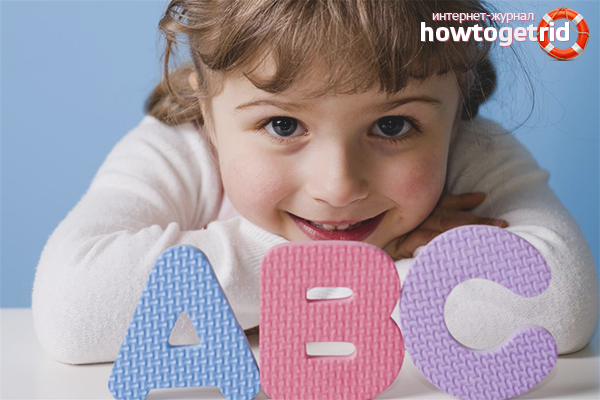The content of the article
English is the basis that any self-respecting person should possess. More than half of the globe speaks English, it is considered universal and to some extent international. To instill a child with a love of the language and the process of learning it is very important to study English at home. Often parents shift responsibility for language learning to teachers in kindergarten and school, to tutors. However, you need to understand that the teacher has 20-30 children at school and only 45 minutes. He cannot devote enough attention to everyone, hence the quality of education. The tutor often deals with the child individually, but only 1-2 times a week. For a quality language study this is not enough. You can attend an experienced teacher, but the process should continue at home. Parents should not let their child’s education drift - you should check, control and guide.
A very important condition under which a mother can teach her baby a foreign language is her own knowledge. If she studied German in school as a child, taking up English from scratch would be more difficult. You can even harm a child by instilling in him the wrong pronunciation, which will be difficult to get rid of. But if mom has a specific school base, this is enough for an early language study. You can invite an English teacher home for a couple of classes, which will help you remember past knowledge and tell you about methods of teaching English for young children.
When can I start training?
Before you begin, you need to understand if your child is ready for the creative process. If the baby freely speaks sentences in his native language - the learning process can begin. In addition, you need to consider the availability of free time for regular classes. After all, from a couple of hours a week there will be no effect. To accumulate at least some vocabulary, you need to do it regularly and every day at least for half an hour for babies and an hour for older children.
Starting to educate a child on their own, get ready to prepare teaching materials, films, cartoons, various cards and pictures. A mother should show a creative approach so that training takes place easily, comfortably and in a playful way.
How to teach a foreign language to a small child
Children of the first five years of life are not ready to study grammar, build complex sentences, understand connecting phrases and analyze them. Learning a language in young children should be built in the same way as you taught your baby the native language. Everything should be extremely clear and consistent. Here are some ways to help you accumulate a small supply of English words in your child’s head 3-4 years old.
- Cartoons This is something that any baby of this age will not refuse. Browse the web, buy or rent cartoons with simple English phrases. At first, children may not understand speech and guess about the meaning of the plot only in context and intonation.However, regular viewing leads to the fact that the child begins to understand the simple phrases “Hallo”, “Bye-Bye”, “Thank you”. It is very important not only to listen to these words, but also to ask the child to repeat them in order to train the pronunciation.
- Cards. This is another way to educate kids. In office supplies there are special cards on which are written the names of furniture, animals, vegetables, body parts and other groups of words. Under each picture there is a name in English. You can repeat these names with your child, and then try to find these items on the street or at home. That is, you point to the table, but not the one in the picture, but the one that’s standing in your house and ask the kid “What is this?” The kid should answer in English “Table”. To make the process more memorable, you can not buy cards, but make them yourself with your child. While the kid is drawing another object or animal, say its name in English several times.
- Use phrases in everyday life. If you have already learned a few words, you need to use familiar phrases in everyday life. Tell your child “Have a nice day” when you leave him in kindergarten, “Good evening” when you send him to bed and “I love you” when you want to express your emotions.
- Give your child an Englishman toy. It can be a hare, a doll or a teddy bear. Tell the child that the bear speaks and understands only in English. This will not only allow you to share the speech, but also make the baby speak, if he is still shy of his pronunciation. That is, when the baby says to the bear: “Go to bed,” tell the baby that the bear does not understand and ask him to pronounce the phrase in English, after prompting it to him. In the future, tips will need less and less. This method of learning the language is also successful because, together with the bear, you can find yourself in various life situations - at the doctor’s appointment, in the buffet, on the playground. A wide range of everyday situations will expand knowledge of the English language and use phrases that may be needed in a particular case.
- Poems, puzzles, songs. Toddlers are best at remembering small and capacious phrases, most often in rhyme. Therefore, adopt short phrases that are easy to remember. For a walk, invite the baby to sing together those songs that he liked. And when dad comes home from work in the evening, be sure to guess one of the learned puzzles.
- All parts of speech. Many parents, dealing with a child on their own, make one common mistake. They teach him only nouns - dog, cat, apple. As a result, the baby can not speak only objects. It is very important to learn adjectives, but don’t talk about parts of speech so explicitly. Just tell your baby that “beautiful” means “beautiful” or “beautiful”. Sit down, get up, run and accompany all these actions with English words. In general, use in training all parts of speech that may come in handy in a simple conversation.
In a conversation with a small child, do not try to build too long and complex sentences. For simple phrases and initial speech, three times are enough for you - Present, Past and Future Indefinite. This knowledge is enough to help the child learn simple colloquial phrases that are used most often.
How to teach a student language
If your child is already in school, you won’t get away with simple phrases. In addition, you need to start learning grammar and spelling. But you must understand that the whole process should be interesting so that the baby does not lose curiosity in learning the language.
Start learning grammar is from the alphabet. It is not difficult to learn the letters, act in the same way as with your native language - show the letter, talk about the words that begin with this letter. Particular attention should be paid to the letters Sh, Ch, C, etc.Work through all the options - in which cases the pronunciation of the letter changes.
When the child learns all the letters, teach him to read simple words. Be mindful of pronunciation and sound reproduction. Here it is very important to prepare not only for the child, but also for the mother herself, regularly filling the knowledge gaps. After all, if one day you miss the wrong pronunciation of a particular word, the baby will be sure that he speaks correctly. This leads to a habit that is quite difficult to eradicate.
After reading simple words, we move on to simple texts. When reading the text, ask the child if he understood everything that remained unknown and incomprehensible to him. Do not constantly prompt the child to translate the word, give him the opportunity to learn on his own. Offer together to find the word you are interested in in the dictionary and find out its meaning. When the baby begins to understand small simple texts, ask him to tell what was discussed. In the process of studying grammar, it is very important to pay sufficient attention to spoken language, which is usually always lame.
To attract your child to reading in English, buy him an interesting book. These may be simple fairy tales, but it is best to purchase a detective story or children's adventures. If the child is about 8-10 years old and has a sufficient vocabulary of English, give the child Tom Sawyer in the original. The book itself is very mesmerizing, the child will try to find out what will happen next, even if some words are not yet clear to him. Interest and curiosity is what training should be based on.
In the future, it is advisable to teach a child independently only if you yourself know the language at a professional level. A more serious speaking and writing skill will only be taught by an experienced teacher or native speaker. Your task, as a parent, is to give your child the base you are capable of. If the classes are interesting, and most importantly, regular, you can achieve impressive results.
Video: how to teach a child to read in English, in 2 months











Submit